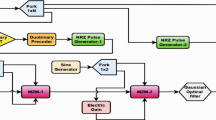Abstract
FBMC-OQAM is reflected as one of the most capable techniques for the next generation mobile communication namely 5G. It has several advantages as compared to orthogonal frequency division multiplexing (OFDM) but it also has some drawbacks like high peak power. Filter bank multi-carrier (FBMC) employs a group of filters at the transmitter and the receiver part of the system. The high peak power decreases the efficiency FBMC system. In this study, a joint (hybrid) peak to average power ratio (PAPR) reduction technique is carried out by using partial transmit sequence (PTS) and tone reservation (TR) for FBMC signals. The blocks of data signal are split into numerous segments and the blocks of each segment are decided on the basis of overlapping factor. In every part, we pick out the optimal block of data to transmit and mutually consider the contiguous coincided block to accomplish reduce peak signal. The simulation results reveal that the proposed technique is better than the conventional PAPR reduction technique. Additionally, k-hybrid PAPR reduction technique is carried out. It is observed that the performance of the proposed k-hybrid technique is better than the hybrid technique.
Similar content being viewed by others
References
S. Ikni, D. Abed, S. Redadaa, M. Sedraoui, “PAPR reduction in FBMC-OQAM systems based on discrete sliding norm transform technique,” Radioelectron. Commun. Syst.62, No. 2, 51 (2019). DOI: https://doi.org/10.3103/S0735272719020018.
Z. Tong, Y. Hu, W. Zhang, “PAPR reduction in CO-OFDM systems using IPTS and modified clipping and filtering,” Optoelectron. Lett.14, No. 3, 209 (2018). DOI: https://doi.org/10.1007/s11801-018-7210-2.
H.-S. Joo, S.-J. Heo, H.-B. Jeon, J.-S. No, D.-J. Shin, “A new blind SLM scheme with low decoding complexity for OFDM systems,” IEEE Trans. Broadcast.58, No. 4, 669 (2012). DOI: https://doi.org/10.1109/tbc.2012.2216472.
X. Qi, Y. Li, H. Huang, “A low complexity PTS scheme based on tree for PAPR reduction,” IEEE Commun. Lett.16, No. 9, 1486 (2012). DOI: https://doi.org/10.1109/lcomm.2012.072012.121228.
A. Hasan, M. Zeeshan, M. A. Mumtaz, M. W. Khan, “PAPR reduction of FBMC-OQAM using A-law and Mu-law companding,” Proc. of 2018 ELEKTRO, 21–23 May 2018, Mikulov, Czech Republic (IEEE, 2018), pp. 1–4. DOI: https://doi.org/10.1109/elektro.2018.8398246.
S. Hu, G. Wu, Q. Wen, Y. Xiao, S. Li, “Nonlinearity reduction by tone reservation with null subcarriers for WiMAX system,” Wireless Pers. Commun.54, No. 2, 289 (2010). DOI: https://doi.org/10.1007/s11277-009-9726-z.
D. Na, K. Choi, “Low PAPR FBMC,” IEEE Trans. Wireless Commun.17, No. 1, 182 (2018). DOI: https://doi.org/10.1109/twc.2017.2764028.
S. S. K. C. Bulusu, H. Shaiek, D. Roviras, “Potency of trellis-based SLM over symbol-by-symbol approach in reducing PAPR for FBMC-OQAM signals,” Proc. of IEEE Int. Conf. on Commun., 8–12 Jun. 2015, London, UK (IEEE, 2015), pp. 4757–4762. DOI: https://doi.org/10.1109/icc.2015.7249075.
Y. Zhou, T. Jiang, C. Huang, S. Cui, “Peak-to-average power ratio reduction for OFDM/OQAM signals via alternative-signals via alternative-signal method,” IEEE Trans. Veh. Technol.63, No. 1, 494 (2014). DOI: https://doi.org/10.1109/tvt.2013.2273557.
Shixian Lu, Daiming Qu, Yejun He, “Sliding window tone reservation technique for the peak-to-average power ratio reduction of FBMC-OQAM signals,” IEEE Wireless Commun. Lett.1, No. 4, 268 (2012). DOI: https://doi.org/10.1109/wcl.2012.062512.120360.
V. S. Kumar, S. Anuradha, “Notice of removal: Sliding window tone reservation using smart gradient projection method for PAPR reduction of FBMC signals,” Proc. of Int. Conf. Elect., Electron., Signals, Commun. Optim., 24–25 Jan. 2015, Visakhapatnam, India (IEEE, 2015), pp. 494–499. DOI: https://doi.org/10.1109/eesco.2015.7253695.
C. Ye, Z. Li, T. Jiang, C. Ni, Q. Qi, “PAPR reduction of OQAM-OFDM signals using segmental PTS scheme with low complexity,” IEEE Trans. Broadcast.60, No. 1, 142 (2014). DOI: https://doi.org/10.1109/tbc.2013.2282732.
S. Vangala, S. Anuradha, “Hybrid PAPR reduction scheme with selective mapping and tone reservation for FBMC/OQAM,” Proc. of 3rd Int. Conf. on Signal Process., Commun. Netw., 26–28 Mar. 2015, Chennai, India (IEEE, 2015), pp. 1–5. DOI: https://doi.org/10.1109/icscn.2015.7219877.
Author information
Authors and Affiliations
Corresponding author
Ethics declarations
The authors declare that they have no conflict of interest.
Additional information
Additional Information
The initial version of this paper in Russian is published in the journal “Izvestiya Vysshikh Uchebnykh Zavedenii. Radioelektronika,” ISSN 2307-6011 (Online), ISSN 0021-3470 (Print) on the link http://radio.kpi.ua/article/view/S0021347019100029 with DOI: https://doi.org/10.20535/S0021347019100029.
Russian Text © The Author(s), 2019, published in Izvestiya Vysshikh Uchebnykh Zavedenii, Radioelektronika, 2019, Vol. 62, No. 10, pp. 593–601.
About this article
Cite this article
Kumar, A. PAPR Reduction of FBMC Using Hybrid and k-Hybrid Techniques. Radioelectron.Commun.Syst. 62, 501–509 (2019). https://doi.org/10.3103/S0735272719100029
Received:
Revised:
Accepted:
Published:
Issue Date:
DOI: https://doi.org/10.3103/S0735272719100029




